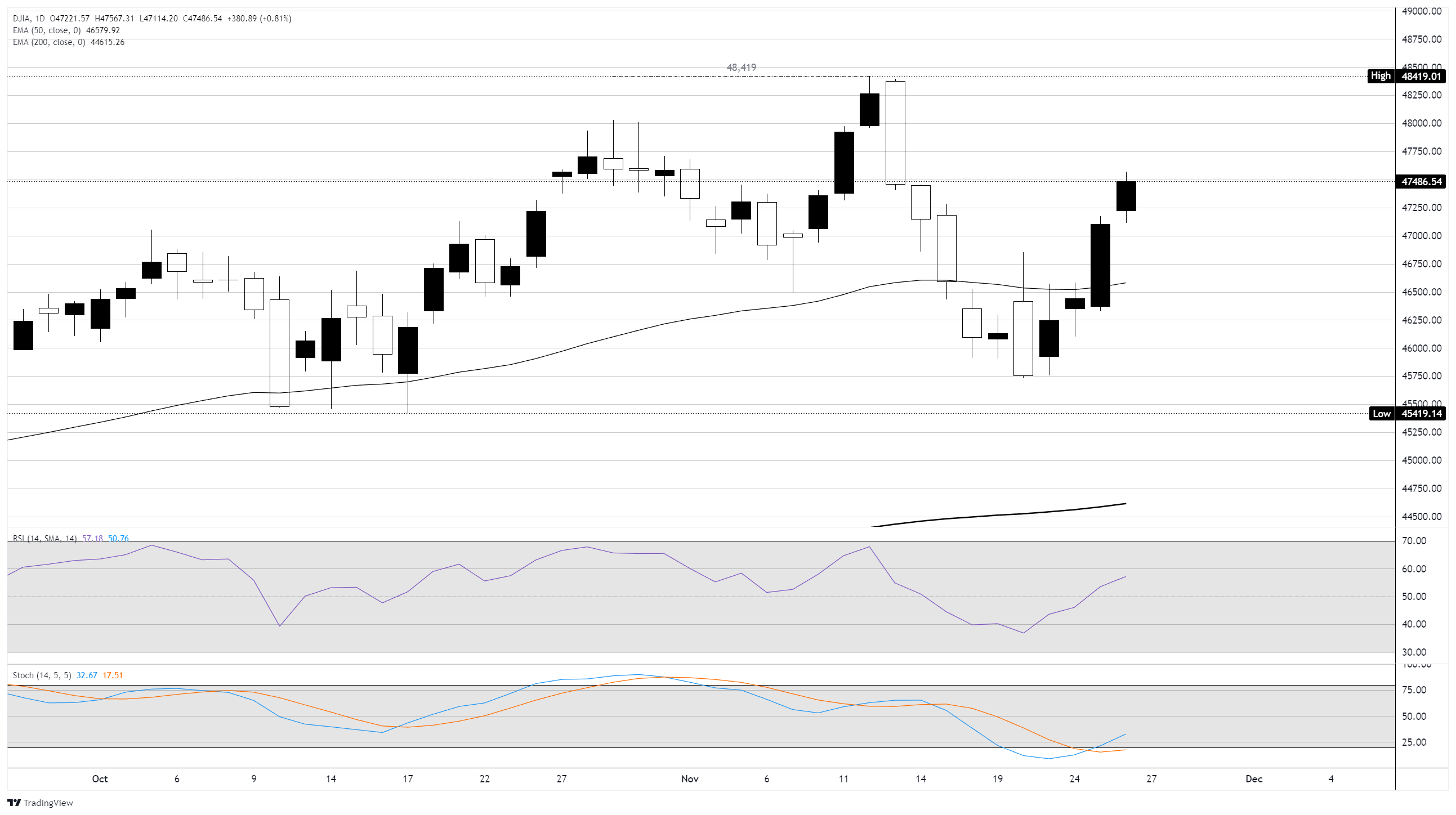Dow Jones Industrial Average climbs for fourth consecutive day on rate cut bets
- The Dow Jones stepped into a fourth straight day of gains on Thursday.
- Markets are tilting into a firm risk-on stance ahead of the Thanksgiving holiday.
- Investor sentiment is hinged entirely on bets of a December Fed rate cut.
The Dow Jones Industrial Average (DJIA) gained another 400 points on Wednesday, clawing back recent losses and testing back above the 47,500 level. The major equity index has stepped into its fourth consecutive day in the green as broader markets tilt into the bullish side ahead of what is now widely expected to be a third straight interest rate cut from the Federal Reserve (Fed).
After a sharp tumble from record highs, the Dow is back on the front foot, climbing 4% from the last swing low into 45,730 despite recent wobbles in the AI-led tech rally. Equities have broadly recovered losses that shook traders heading into mid-November, and high expectations for further Fed interest rate cuts are driving stocks and investor sentiment higher.
Rate cut hopes continue to drive market higher
According to the CME’s FedWatch Tool, rate traders see over 80% odds of a third straight quarter-point rate trim from the Federal Open Market Committee (FOMC) on December 10. Several key FOMC voting members pivoted into a surprisingly dovish stance over the past week, and the Fed’s overall tone on potential interest rate cuts has shifted dramatically from the overly cautious stance from the last rate meeting.
Despite a few hitches and stutters in the AI-led tech rally, equities are set to wrap up an otherwise strong week early. American Thanksgiving will see markets in low-activity mode through Thursday and Friday.
Dow Jones price forecast
In the daily chart, the Dow is churning near the 47,500 region. Price action remains on the high side of the rising 50-day Exponential Moving Average (EMA) and well above the 200-day EMA, preserving the broader uptrend. The short-term average has turned higher again, reinforcing near-term bidding momentum. The Relative Strength Index (RSI) at 57.63 holds above the midline, confirming improving momentum.
The Stochastic slow oscillator (14,5,5) is turning up from oversold, indicating sellers are losing grip. Holding above the 50-day EMA would keep the focus on the trend-line barrier; a decisive break could extend the advance, while failure there would leave the index vulnerable to a pullback toward the 200-day EMA.
Dow Jones daily chart

Dow Jones FAQs
The Dow Jones Industrial Average, one of the oldest stock market indices in the world, is compiled of the 30 most traded stocks in the US. The index is price-weighted rather than weighted by capitalization. It is calculated by summing the prices of the constituent stocks and dividing them by a factor, currently 0.152. The index was founded by Charles Dow, who also founded the Wall Street Journal. In later years it has been criticized for not being broadly representative enough because it only tracks 30 conglomerates, unlike broader indices such as the S&P 500.
Many different factors drive the Dow Jones Industrial Average (DJIA). The aggregate performance of the component companies revealed in quarterly company earnings reports is the main one. US and global macroeconomic data also contributes as it impacts on investor sentiment. The level of interest rates, set by the Federal Reserve (Fed), also influences the DJIA as it affects the cost of credit, on which many corporations are heavily reliant. Therefore, inflation can be a major driver as well as other metrics which impact the Fed decisions.
Dow Theory is a method for identifying the primary trend of the stock market developed by Charles Dow. A key step is to compare the direction of the Dow Jones Industrial Average (DJIA) and the Dow Jones Transportation Average (DJTA) and only follow trends where both are moving in the same direction. Volume is a confirmatory criteria. The theory uses elements of peak and trough analysis. Dow’s theory posits three trend phases: accumulation, when smart money starts buying or selling; public participation, when the wider public joins in; and distribution, when the smart money exits.
There are a number of ways to trade the DJIA. One is to use ETFs which allow investors to trade the DJIA as a single security, rather than having to buy shares in all 30 constituent companies. A leading example is the SPDR Dow Jones Industrial Average ETF (DIA). DJIA futures contracts enable traders to speculate on the future value of the index and Options provide the right, but not the obligation, to buy or sell the index at a predetermined price in the future. Mutual funds enable investors to buy a share of a diversified portfolio of DJIA stocks thus providing exposure to the overall index.

